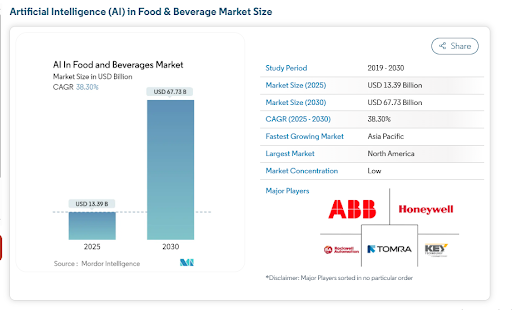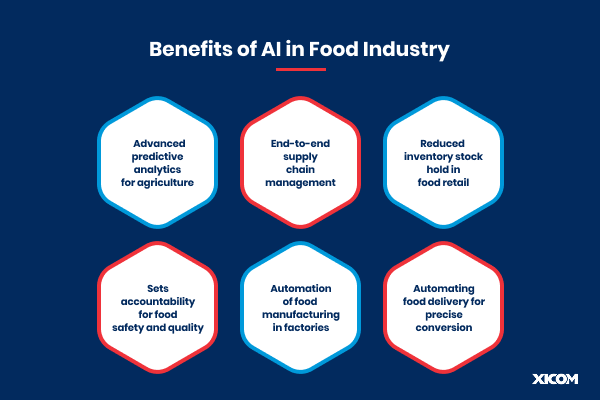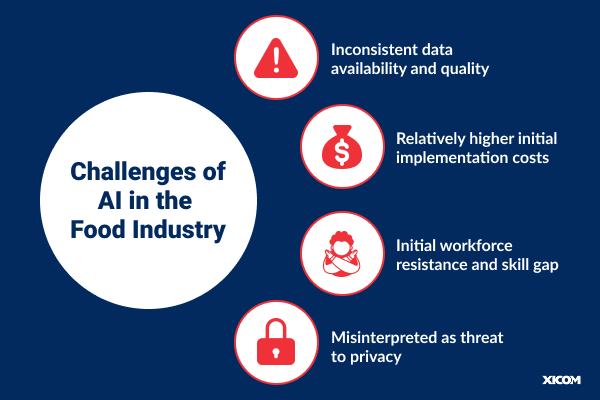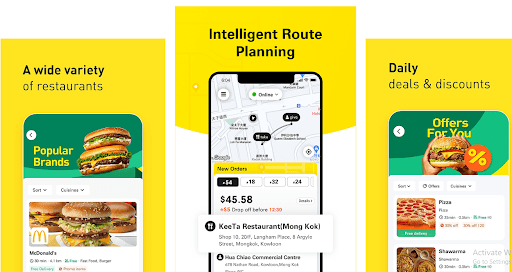May 23, 2025 Artificial Intelligence
AI in the Food Industry: Transforming the Food from Farms to Forks
May 23, 2025 Artificial Intelligence
Table of Contents
May 23, 2025 Artificial Intelligence
Technology in the current world is improving the DNA of the industries, and the food industry is no exception. From thinking of expansions to overcoming setbacks, the first thing that one thinks of is
“There must be some technology to help me overcome this challenge?”
One of the finest case studies of technology/AI in the food industry is of Tyson Foods. The company today uses computer vision and automation to improve their meat processing. This decision came shortly after they faced challenges with shortage of labour due to COVID-19 pandemic in 2020.
Workers’ illness or COVID-19 safety protocols led to slowing down the production and disrupting the entire supply chain.
In response, Tyson Foods decided to steer its way through the technology route. They accelerated their investment in robotics, computer vision, and machine learning technologies, starting 2021. Tyson announced that it would invest over $1.3 billion by the end of 2024 in automation and digital transformation of their production processes.
Key focused areas:
Instant Impact:
As a result, Tyson was successful in maintaining output irrespective of the challenges and set a safer, smarter, and more resilient way in food production systems.
Well, that is how technology has erupted and transformed the food industry and its functions since decades now.
Automation through AI in food industry has significantly transformed the entire journey of food from farms to forks. There is a new-age technology that assists in producing, storing, delivering, and consuming food.
Machine learning, generative AI, data analytics, and computer vision are some of the fundamental technologies behind revolutionizing the bottomline of the food industry. They are widely preferred in improving agricultural practices, optimizing production and supply chain, reducing waste, and planning production with predictive analysis from churning the precisely available data.
AI is taking over the end-to-end supply chain to apply mechanisms for reducing waste and adopting intelligent agricultural practices to improve yield. With its capability of being highly personalised, it is impacting efficiency and sustainability, irrespective of the food sector, hierarchy, or segment.

Source: Mordor Intelligence
This is why the current market size of the AI in the food and beverage industry is all set to cross USD 9.68B by the end of 2025. Growing at a CAGR of 38.30%, it is expected to reach USD 48.99B by 2029.
Recent studies have found that in the near future AI will help in cutting production costs by up to 20% in the agricultural sector specifically.
The way the application of AI in food industry is evolving, it is going to be a game-changer in multiple ways.
Let us find out about more of its implications in the following parts of this blog.

With the advancement in AI, latest predictive analytics are capable of precisely forecasting weather and crop yield predictions. The science behind this is that it analyses huge chunks of data regularly collected by drones, sensors, and satellites to monitor soil’s health, pest infestation if any, thereby resulting in healthier yields. This saves farmers’ time and cost otherwise incurred in field trials and food inspections.
Supply chains function as the nervous system that connects and coordinates the entire industry ecosystem. With its fundamental role of tracking products throughout, it additionally helps in managing inventories, conducting the quality check (QC) at the entry level, and ensuring best practices throughout the operational services.
AI in the food service industry is being used more than ever in the current age. Not only its predictive analytics help in forecasting demand, but also reduce wastage. Automated accurate predictions, on the basis of data collected by AI, is one of the most powerful features of AI to reimagine the entire game in the food industry.
AI in food industry is making companies more accountable by instilling compliance and transparency. From identifying staff that is not following the food safety protocols on the floor to tracking the production in real-time, it sees, captures, and highlights even the minutest details that can contaminate the entire produce. Smart isn’t it? Good quality, accountable supply chain, and significantly saved hours.
Having a similar productivity 365 days is manually impossible. Because humans are not machines. But to effectively cut through the competition, one can enable technology, AI and robotics to eradicate all possible delays.
With application of AI in food industry and robots, the entire process of sorting, categorizing, cleaning, and packing food in different containers become autonomous.
Robots or automated machines will self move and undertake processes to convert raw materials into finer goods ready to move out of production to their next destination.
AI plays a crucial role in automating the entire food delivery process and makes it faster, smoother, and efficient.
Let us take an example of Uber Eats here. When you open the app, it analyzes your location and suggests your preferred restaurants depending on your browsing history, order history, and location. After you place an order, it automatically assigns the delivery partner on the basis of their location, workload, and delivery history. Additionally, the AI predicts peak order time and locations, helping restaurants to make preparations in advance.
In order to successfully integrate AI with your existing food industry, you’ll need a more defined approach that will include cohesive planning, data integration, and execution. Below is the 10-steps guide to help you successfully integrate AI in the food industry.
Identify areas in your food industry where AI can replace human and add most value, such as inventory management, supply chain management, customer service, or quality control.
How to do it:
AI works on data, just data! The better your accumulation and organization of data would be, the better it will work as a generative AI in food industry.
How to do it:
Analyze and select for the AI tools and technologies that perfectly align with your opportunities and hold capabilities to extinct current business challenges.
How to do it:
Effortlessly integrate AI in your existing system without disrupting the entire workflow.
How to do it:
Start integrating the program in stages. Do not fully load it at once, increase your dependency on AI step by step.
How to do it:
To make the adaptation process easy, conduct frequent AI training in the beginning and help them understand its benefits.
How to do it:
Constantly measure the performance of the AI in food industry, and optimize it on the basis of data and feedback generated.
How to do it:
Once the pilot phase is over and successful, now you can expand AI to other branches or departments.
How to do it:
Keep an eye on advancements in AI in food industry. Stay up to date with the latest developments and their impact.
How to do it:
Make sure that AI implementation is fully ethical, transparent, and does not hinder individual’s privacy.
How to do it:
Switching from contemporary methods to something new is always challenging. And, AI in the food industry is no exception. When you’re moving towards technology, there will be some barriers. Let us explore each one of those in detail and how you can overcome them.

Inconsistency in data can be a big hurdle for AI to perform its functions accurately. While the existing data can be minimal, adoption of AI can help you overcome this challenge as the machine learning consulting services company will help you develop an AI system that can implement robust data collection, categorization, and its integration into the system to create reliable data sets.
There is no doubt about AI solutions being costly solutions. Therefore, AI solutions can be developed and deployed in stages to help food production businesses incur such heavy costs in smaller installments.
Lack of AI expertise and resistance to change are two commonly pointed out challenges. This can be easily overcome by user-friendly tools and initial training to make the transition smoother.
Initial resistance to switch can also be due to AI or technology being misinterpreted as a threat to privacy. But such is not the case. Such software/AI solutions are made legal guidelines in mind to protect data and promote its legitimate usage.
AI, or Artificial Intelligence is set to disrupt the existing food industry and drastically enhance its efficiency, sustainability and consumer satisfaction. As AI is continuously evolving and seamlessly integrating into various aspects of the food value chain, from production to consumption, it is becoming highly transformative.
In the agricultural sector, AI will play a crucial role in precision farming. Drones, advanced sensors, and machine learning (ML) models will enable farmers to monitor health of the crop, predict yields, and carefully optimize irrigation and pesticide usage. Thus, it will not only increase productivity, but will also support sustainable production.
In food processing and manufacturing units, automation powered by AI will streamline operations, assist in quality control, and minimize the chances of human errors. Machine vision can detect defects, while proactive predictive maintenance systems can warn for system maintenance and reduce downtime. AI can also facilitate in developing new products from its analyses on consumer trends and preferences.
Supply chain is another major area that will be highly impacted. AI will enhance precisely accurate demand forecasting, aid in inventory management, logistics and enhance sustainability to reduce food wastage. Real-time data analytics helping understanding changing market conditions and scenarios, such as seen during global events like COVI-19 pandemic.
Last but not the least, consumer experiences will also transform. AI has started taking over direct consumers as well. With personalized nutrition, recipe suggestions, smart kitchen assistants, aids to cater to individual health needs, generative AI in the food industry will enhance overall consumer interaction and engagement.
Despite its bright promises and work, AI in food industry will require constant checks to cater to challenges like data security, ethical concerns, and constant need for the workforce to upskill. With responsible implementation and fair usage, AI has the potential to create an intelligent, safe and sustainable food ecosystem for the future.

Keeta is the new-age food delivery app developed by Xicom Technologies to cater to the evolving needs of the urban consumers. It has its headquarters in Hong Kong and internationally linked with China’s brand name Meituan.
Keeta is designed to offer:
Keeta collaborated with Xicom, software development services company to reimagine its platform’s performance, ace the user experience on the platform, and aid in scaling up.
Here are the set of challenges that Keeta came with to Xicom.
Solutions:
As the first step, we delivered a customized, multi-lingual, and high performing food delivery platform with modern UI, real-time features, and options to facilitate global scalability.
Being the top AI development company, Xicom Technologies crafted a comprehensive, user-centric food delivery app for Keeta. Our team implemented a sleek UI that aligned with brand’s color theme and ensured a smooth navigation. React was used as the fundamental technology to create a seamless frontend that could run across devices.
Technologies like Node.js and MangoDB were picked to enable quick data processing, and Firebase supported real-time order tracking. Along with it, the built in multilingual support ensured global accessibility, secure payment gateways instilled trust and responsive in-app support worked together to create a wholesome experience.
These crucial technological advancements helped Keeta achieve:
You can refer to the full case study here: Xicom Keeta
AI in food industry is helping companies upgrade their key areas of operation. One such case study of Keeta, the HongKong based food delivery app, is also shared above. It explains how Xicom Technologies, the top AI development agency, helped Keeta upgrade their UI, UX, route optimization to achieve precisely accurate in-app experience for their customers.
AI just does not integrate another layer of innovation, it focuses on revolutionizing your entire business and its processes. It starts from improving food safety, to sustainability, and focusing on reducing wastage to promote sustainable production.
Planning to integrate an AI solution and make processes in your food industry operations seamless? Connect with us now!
AI helps in optimizing agricultural yields by monitoring data through drones and vision sensors, then automating the food manufacturing with the help of robotics, streamlining the supply chain management, and enhance food safety with technologies like robotics, machine learning, and robotics.
AI enhances efficiency, reduces dependency on manual labour, improvises quality control standards, reduces food wastage, and enable predictive maintenance for system in food processing units.
Some of the crucial challenges faced by AI in the food industry are low-quality data, resistance from the workforce, AI skill gaps, and privacy threats.